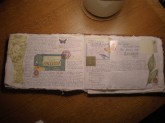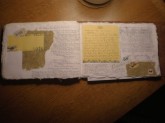Journaling with Words and Images
This is the third in a series of interviews with Joan Gregory.
I met Joan in a course I was taking. One day she happened to bring her journal to class which was filled with quotes, drawings, and collage as well as writing and notes. Several of us were interested enough that she agreed to do a short workshop for us before the class started one day. In the workshop we learned how to make a simple book and how to work with special papers and decorative elements. I loved it and asked her to talk to me more about this type of work, Art Journaling.
Once the change to a more visual form happened, and you began laying out journal pages and fitting the writing into the space rather than writing and fitting the images into the space, how did your work develop?
 Initially I would write and then add an image or highlight a passage with color. Then, as I mentioned, I would prepare pages ahead of time so I could just fill in the blanks later with writing, but now I’ll go back and forth between the two approaches. You never want to get to a place where you‘re not writing (and I have been there) because you haven’t got a visually attractive page ready yet. I think it’s important to know that you can always go back to a page at a later date and add ‘stuff’.
Initially I would write and then add an image or highlight a passage with color. Then, as I mentioned, I would prepare pages ahead of time so I could just fill in the blanks later with writing, but now I’ll go back and forth between the two approaches. You never want to get to a place where you‘re not writing (and I have been there) because you haven’t got a visually attractive page ready yet. I think it’s important to know that you can always go back to a page at a later date and add ‘stuff’.
Often I’ll formulate the page as I write. It has reached the point where I can visually map out a page, like a puzzle, ahead of time and write in some boxes leaving room in alternate boxes for images or text. For example, if I transcribe a poem and it mentions birds, I would know to look for a bird image. Once you start this kind of thing it takes on a life of its own and any rules you thought you had fly out the window. Your imagination soars. In other words, the layouts develop through trial and error and lots of practice. It’s really a very intuitive process and something anyone with the willingness to spend the time at will get the hang of.
How do you suggest someone start becoming more visual?
Each person will bring their own unique signature to the page. Adopt a magpie point of view; begin collecting whatever catches your eye, images and articles from magazines, cards, wrapping paper, etc., then start. Get a shallow box, lids work well, trays do too, or a file folder and add to it as you find things.
 To get you thinking differently about the white page, try sectioning it off into quadrants changing the size of each ‘box’ for interest’s sake. Write in one, color one or two, draw or add images to the other. Use rubber stamps to add an individual graphic or an allover background pattern. Take several pieces of your favorite papers, rip or cut them and paste them onto the page. Embellish with rub on transfers which are still a favorite of mine and can be found at any shop that carries scrapbooking supplies.
To get you thinking differently about the white page, try sectioning it off into quadrants changing the size of each ‘box’ for interest’s sake. Write in one, color one or two, draw or add images to the other. Use rubber stamps to add an individual graphic or an allover background pattern. Take several pieces of your favorite papers, rip or cut them and paste them onto the page. Embellish with rub on transfers which are still a favorite of mine and can be found at any shop that carries scrapbooking supplies.
A good graphics book, something like The Non-Designer’s Design Book – Design and Typographic Principles for the Visual Novice by Robin Williams or The Graphic DESIGN Cookbook – Mix + Match Recipes for Faster, Better Layouts by Koren and Meckler are two I like that will give you infinite possibilities for laying out a page, or look in any magazine for a design you like. No need re-inventing the wheel! I keep a binder of magazine layouts for ideas.
For inspiration I keep my favorite colored pens, a tray of alphabet stickers, transfers and quotes nearby so I can include them on the page. I had placed a quote vertically before and liked the look of it, it broke up the horizontal repetitiveness so then that became a design element for future pages.
So it seems part of this is simply getting to the place where you are willing to play and explore?
Absolutely. Enjoy it. I recently listened to Clarissa Pinkola Estes, the wonderful cantedora (storyteller) on a webinar program hosted by Sounds True who sagely said, “Perfection is the enemy of done.” I love that! When you’re a child playing and having an adventure you’re not thinking, “Am I doing this perfectly?” So don’t be critical of your work, just do it and keep going, being mindful that what you’re creating is for you, it’s your personal style. It’s about what you love, what you find beautiful, what you are interested in.
What kinds of things have you learned as you’ve explored?
One of the things I noticed was that by adding papers, tags and other items to a commercial journal the pages of the book became thicker; it expanded and would no longer lay flat. To prevent this from happening I learned to remove some pages ahead of time. As a result of the technical concerns, I began taking an interest in bookbinding and how to make a book from scratch, specifically for art journaling. I have taken several courses and now have more options for the overall design of the journal. I can determine the size of it, what kind of paper(s) to use and how I want to bind it.
Something else I started doing fairly early on was choosing a theme for the journal. My second journal began as a Gratitude journal, the third was a Water/Ocean journal, the fourth was titled, “On the Wing” – a journal inspired by birds, insects and angels… and so on. It is yet another way to be creative. It also helps to define what you are going to collect for paper and graphics.
Can you tell us more about how you use ephemera in your journals?
The definition of ephemera is “something short-lived or transitory, especially all types of paper documents, printed and handwritten, produced for a specific purpose and intended for disposal”. Some examples are telephone book pages, wrapping paper, greeting cards, post cards, cancelled postage stamps, advertising, transportation tickets, parking tickets, concert tickets, bills, newspapers, last month’s horoscope, tourist brochures, gift tags, transfers, notices, candy wrappers, food labels, wine labels, and shipping labels.
Any of these bits and pieces can help jump start your writing. Reach into your stash of ephemera, don’t even look at what you are pulling out; paste it in your book and create a story around it. Or document your day using the items you’ve collected while out and about. On a holiday last year, I visited a café called Insomnia. I kept one of the long tubular sugar packages with their name on it and am saving it for a journal entry when I can’t get to sleep.
I once did an entire journal using tea ephemera as inspiration. I had collected a lot of paper tags off of tea bags and tea bag packages and by adding definitions and descriptions of different types of tea, quotes about the drinking of tea, etc. I ended up with a sixty page journal!
There’s no reason to be stuck for ideas.
But, what do you do if you do feel stuck?
If it’s the art angle that you are stuck on and not feeling particularly creative simply choose an image, some patterned paper and a quote and glue them to your page. Now choose two coordinating colored pens and begin writing!
For me it’s not so much being stuck as being distracted. If I don’t commit to journaling first thing in the morning, sitting and writing while I have my first cup of coffee, if I start with email or something else, then the moment’s passed and I may not be able to get back to it that day. Pick a time that will work for you and then commit to it. You must believe that what you want to write is valuable and a worthwhile use of your time.
Try not to have an expectation of producing a whole page every day. Sometimes I’ll just have a date; it’s not that I’ve had nothing to write about, the date still marks what happened. It says, “Oh look, she’s distracted again!”
When it goes beyond distraction and I am really feeling like there’s no movement I’ll explore that. I’ll question why I’m feeling that way and write what comes up. There’s always something lying just beneath the surface. I see it as a great opportunity to use the journal process for one of its strongest benefits – guidance. This type of writing helps discern causes and solutions for these ‘stuck’ feelings.
“There’s such a pleasure each morning in getting to the desk, then sitting down in front of the old white page and waiting for something. It’s a very exciting life to put yourself in the way of visitation”. – John O’Donohue
Next time: Shaping the work and special journals.
